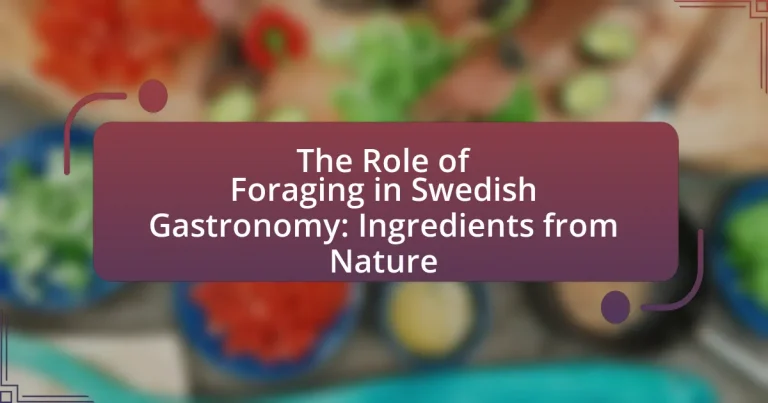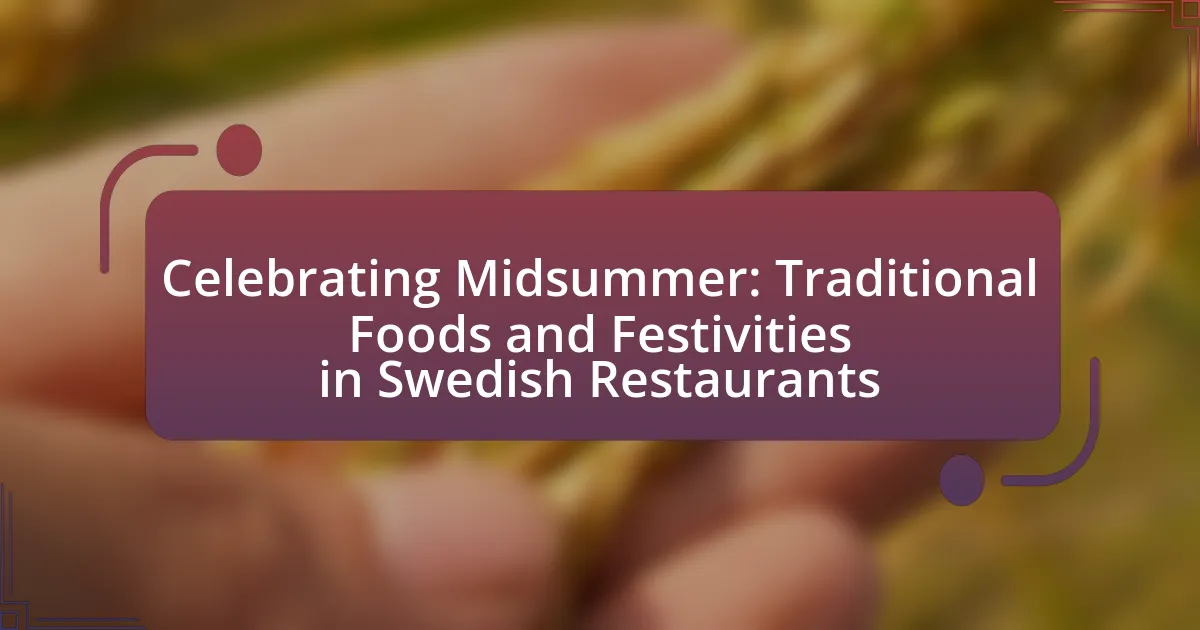Foraging is a fundamental aspect of Swedish gastronomy, providing fresh, seasonal, and local ingredients that enhance traditional dishes. This practice is deeply embedded in Swedish culture, with a rich variety of edible plants, mushrooms, and berries available in the natural landscape. The article explores how foraging influences traditional cuisine, its historical roots, and cultural attitudes that promote sustainability. It also highlights commonly foraged ingredients, the environmental benefits of foraging over commercial farming, and the challenges chefs face when incorporating wild foods into their dishes. Additionally, it discusses responsible foraging practices, available resources for aspiring foragers, and the role of local foraging groups in enhancing the foraging experience.

What is the Role of Foraging in Swedish Gastronomy?
Foraging plays a crucial role in Swedish gastronomy by providing fresh, seasonal, and local ingredients that enhance traditional dishes. This practice is deeply rooted in Swedish culture, where the natural landscape offers a variety of edible plants, mushrooms, and berries, such as lingonberries and chanterelles. The significance of foraging is reflected in the increasing popularity of New Nordic cuisine, which emphasizes sustainability and the use of local resources. Studies indicate that foraging not only supports biodiversity but also fosters a connection between people and their environment, reinforcing the importance of nature in culinary practices.
How has foraging influenced traditional Swedish cuisine?
Foraging has significantly influenced traditional Swedish cuisine by integrating wild ingredients into everyday cooking. This practice has led to the incorporation of various foraged items such as mushrooms, berries, and herbs, which are abundant in Sweden’s diverse landscapes. Historical evidence shows that foraging has been a vital part of Swedish food culture for centuries, with traditional dishes often featuring seasonal wild foods that reflect the local environment. For instance, dishes like lingonberry sauce and chanterelle mushroom soup highlight the importance of foraged ingredients in enhancing flavors and nutritional value. The Swedish concept of “allemansrätten,” or the right to roam, further supports this culinary tradition by encouraging people to gather wild food responsibly, thus maintaining a strong connection between nature and cuisine.
What historical factors contributed to foraging practices in Sweden?
Foraging practices in Sweden have been significantly influenced by historical factors such as the country’s geography, climate, and cultural traditions. The diverse landscapes, including forests, lakes, and coastal areas, have provided a rich variety of edible plants and fungi, facilitating foraging as a sustainable food source. Additionally, Sweden’s long-standing agricultural practices, dating back to the Viking Age, emphasized a connection to the land and seasonal cycles, which encouraged the gathering of wild foods. Cultural traditions, including the concept of “allemansrätten” or the right to roam, have legally supported foraging activities, allowing individuals to access natural resources freely. These historical elements collectively shaped the foraging practices that are integral to Swedish gastronomy today.
How do cultural attitudes towards foraging shape Swedish gastronomy?
Cultural attitudes towards foraging significantly shape Swedish gastronomy by promoting the use of wild, natural ingredients in traditional and contemporary dishes. In Sweden, foraging is deeply rooted in the cultural heritage, with practices passed down through generations, emphasizing sustainability and a connection to nature. This cultural appreciation for foraging is reflected in the popularity of dishes that incorporate ingredients like mushrooms, berries, and herbs, which are often featured in seasonal menus across the country. Additionally, the Swedish concept of “Allemansrätten,” or the right to roam, encourages individuals to explore and gather from the land, further embedding foraged ingredients into the culinary landscape. This integration of foraged foods not only enhances the flavor profiles of Swedish cuisine but also fosters a sense of identity and pride in local, natural resources.
What types of ingredients are commonly foraged in Sweden?
Commonly foraged ingredients in Sweden include mushrooms, berries, herbs, and wild greens. Specifically, popular mushrooms such as chanterelles and porcini are sought after, while berries like lingonberries, blueberries, and cloudberries are frequently harvested. Additionally, herbs such as wild garlic and various edible flowers contribute to the foraged landscape. This practice is supported by Sweden’s “Allemansrätten,” or the Right of Public Access, which allows individuals to forage freely in nature, promoting a deep-rooted cultural connection to local ingredients.
Which wild plants are popular among Swedish foragers?
Popular wild plants among Swedish foragers include bilberries, lingonberries, and wild garlic. Bilberries, similar to blueberries, are sought after for their flavor and nutritional value, while lingonberries are prized for their tartness and are often used in traditional dishes. Wild garlic, known for its distinctive taste, is commonly foraged in spring and adds a unique flavor to various recipes. These plants are not only integral to Swedish cuisine but also reflect the country’s rich foraging culture, which emphasizes the use of natural ingredients in gastronomy.
What types of mushrooms are sought after in Swedish forests?
In Swedish forests, sought-after mushrooms include chanterelles, porcini, and morels. Chanterelles are prized for their delicate flavor and are commonly found in coniferous and deciduous forests during summer and autumn. Porcini, known for their rich taste, thrive in various forest types and are typically harvested in late summer to early autumn. Morels, with their unique appearance and earthy flavor, are sought after in spring. These mushrooms are not only popular in Swedish cuisine but also contribute significantly to the local foraging culture, reflecting the importance of natural ingredients in Swedish gastronomy.
Why is foraging considered sustainable in Swedish gastronomy?
Foraging is considered sustainable in Swedish gastronomy because it promotes biodiversity and utilizes natural resources without depleting them. This practice aligns with Sweden’s cultural heritage and environmental values, as it encourages the harvesting of wild plants, mushrooms, and berries in a manner that respects ecosystems. Research indicates that foraging supports local food systems and reduces carbon footprints associated with industrial agriculture, as it relies on naturally occurring food sources. Additionally, Sweden’s “Allemansrätten” or “Everyman’s Right” allows individuals to forage responsibly, ensuring that the practice is regulated and sustainable.
How does foraging promote biodiversity in Swedish ecosystems?
Foraging promotes biodiversity in Swedish ecosystems by encouraging the sustainable harvesting of a wide variety of wild plants, fungi, and animals, which helps maintain genetic diversity. This practice supports the survival of multiple species by preventing over-reliance on cultivated crops, thereby fostering a more resilient ecosystem. Research indicates that foraging can enhance habitat complexity and contribute to the preservation of native species, as it often involves the collection of diverse edible resources that coexist in natural environments. Additionally, foraging activities can raise awareness about local flora and fauna, leading to increased conservation efforts and community engagement in biodiversity protection.
What are the environmental benefits of foraging over commercial farming?
Foraging offers significant environmental benefits compared to commercial farming, primarily by promoting biodiversity and reducing carbon footprints. Foraging allows individuals to harvest wild plants and mushrooms, which supports the natural ecosystem and maintains genetic diversity among species. In contrast, commercial farming often relies on monocultures, which can deplete soil health and reduce biodiversity. Additionally, foraging typically requires less land and resources, leading to lower greenhouse gas emissions associated with transportation and cultivation. Studies indicate that foraging can enhance local ecosystems by encouraging sustainable practices and minimizing the use of chemical fertilizers and pesticides, which are prevalent in commercial agriculture.
How does foraging connect modern chefs to traditional practices?
Foraging connects modern chefs to traditional practices by reviving age-old techniques of sourcing food directly from nature. This practice reflects a deep-rooted cultural heritage where communities relied on local flora and fauna for sustenance, a method that has been documented in various historical texts, such as “The Nordic Cookbook” by Magnus Nilsson, which emphasizes the importance of local ingredients in Scandinavian cuisine. By incorporating foraged ingredients, contemporary chefs not only honor these ancestral methods but also enhance their culinary creations with unique flavors and seasonal freshness, thereby fostering a sustainable relationship with the environment.
What role do foraging workshops play in Swedish culinary education?
Foraging workshops play a crucial role in Swedish culinary education by providing hands-on experience in identifying and utilizing wild ingredients. These workshops enhance students’ understanding of local ecosystems and promote sustainable practices in cooking. By engaging with nature, culinary students learn to appreciate the flavors and nutritional benefits of foraged foods, which are integral to traditional Swedish cuisine. Research indicates that incorporating foraging into culinary training fosters creativity and innovation, allowing chefs to create unique dishes that reflect the natural landscape of Sweden.

What are the culinary applications of foraged ingredients?
Foraged ingredients have diverse culinary applications, enhancing dishes with unique flavors and nutritional benefits. Chefs utilize wild herbs, mushrooms, berries, and greens to create innovative recipes that reflect local ecosystems. For example, foraged chanterelle mushrooms are often sautéed and served with meats or incorporated into sauces, while wild berries like lingonberries are used in jams, desserts, and as accompaniments to savory dishes. The use of foraged ingredients not only promotes sustainability by reducing reliance on commercial agriculture but also connects diners to the natural landscape, as seen in Swedish gastronomy where seasonal foraging is celebrated.
How do chefs incorporate foraged ingredients into their dishes?
Chefs incorporate foraged ingredients into their dishes by utilizing wild plants, mushrooms, and herbs that are locally sourced from nature. This practice enhances the flavor profile and nutritional value of their meals, as foraged ingredients often possess unique tastes and health benefits not found in cultivated varieties. For example, chefs in Sweden frequently use ingredients like wild garlic, chanterelles, and berries, which are abundant in the region’s forests and meadows. The incorporation of these ingredients not only supports local ecosystems but also aligns with the growing trend of sustainable and seasonal cooking, reflecting a deep connection to the land and its natural offerings.
What are some signature dishes that highlight foraged ingredients?
Signature dishes that highlight foraged ingredients in Swedish gastronomy include “Grilled Reindeer with Lingonberry Sauce,” “Wild Mushroom Risotto,” and “Foraged Herb Salad.” These dishes utilize ingredients such as wild mushrooms, lingonberries, and various edible herbs, showcasing the rich flavors and textures found in nature. For example, grilled reindeer is often paired with lingonberries, which are commonly foraged in Sweden, providing a tart contrast to the savory meat. Wild mushrooms, like chanterelles, are frequently featured in risottos, emphasizing the seasonal bounty of the forest. Foraged herb salads incorporate a variety of wild greens, enhancing the freshness and complexity of the dish.
How do foraged ingredients enhance flavor profiles in Swedish cuisine?
Foraged ingredients enhance flavor profiles in Swedish cuisine by introducing unique, seasonal, and locally-sourced flavors that reflect the natural environment. These ingredients, such as wild berries, mushrooms, and herbs, contribute distinct tastes and aromas that are often absent in cultivated foods. For example, the use of lingonberries adds a tartness that complements savory dishes, while chanterelle mushrooms provide an earthy depth. The incorporation of these foraged elements not only elevates the overall taste but also connects the cuisine to its cultural and ecological roots, emphasizing the importance of sustainability and local biodiversity in Swedish gastronomy.
What challenges do chefs face when using foraged ingredients?
Chefs face several challenges when using foraged ingredients, primarily related to identification, safety, and sustainability. Accurate identification of wild plants and mushrooms is crucial, as misidentification can lead to toxic consumption; for example, the death cap mushroom can be fatal if mistaken for edible varieties. Additionally, chefs must ensure that foraged ingredients are safe to consume, as some may carry contaminants or pesticides from their environment. Sustainability is another concern, as overharvesting can deplete local ecosystems, making it essential for chefs to practice responsible foraging techniques. These challenges necessitate a deep understanding of local flora and a commitment to ethical sourcing practices.
How do seasonal variations affect the availability of foraged ingredients?
Seasonal variations significantly influence the availability of foraged ingredients by dictating the growth cycles of plants and the behavior of wildlife. For instance, spring brings an abundance of wild greens and mushrooms, while summer offers berries and herbs. In contrast, autumn is characterized by the harvest of nuts and late-season fruits, and winter limits foraging primarily to evergreen plants and certain fungi. Research indicates that specific foraged items, such as chanterelles, peak in availability during particular months, with chanterelles typically flourishing in late summer to early autumn. This cyclical pattern is essential for foragers to understand in order to optimize their harvests and align with nature’s rhythms.
What regulations govern foraging in Sweden?
Foraging in Sweden is primarily governed by the Allemansrätten, or the Right of Public Access, which allows individuals to forage for wild berries, mushrooms, and flowers on uncultivated land. This right is balanced by the requirement to respect private property and the environment, meaning foragers must avoid damaging plants or disturbing wildlife. Additionally, specific regulations may apply to certain protected areas, where foraging could be restricted to preserve biodiversity. The Swedish Environmental Protection Agency provides guidelines to ensure sustainable foraging practices, emphasizing the importance of responsible harvesting to maintain ecological balance.

How can individuals engage in foraging responsibly?
Individuals can engage in foraging responsibly by adhering to local regulations, ensuring sustainable practices, and respecting the environment. Responsible foraging involves identifying edible plants accurately to avoid toxic species, which is crucial for safety. Additionally, foragers should only harvest what they need, leaving enough for wildlife and plant regeneration, thereby promoting ecological balance. Research indicates that sustainable foraging practices help maintain biodiversity and support local ecosystems. For example, the Swedish Environmental Protection Agency emphasizes the importance of respecting nature and following guidelines to prevent overharvesting and habitat destruction.
What guidelines should foragers follow to ensure sustainability?
Foragers should follow the guideline of harvesting only what they need to ensure sustainability. This practice prevents over-exploitation of natural resources and allows ecosystems to regenerate. Additionally, foragers should be knowledgeable about local regulations and protected species, as certain plants and fungi may be endangered or restricted from collection. Research indicates that sustainable foraging practices contribute to biodiversity conservation and ecosystem health, as highlighted in the study “Sustainable Foraging: A Guide to Responsible Harvesting” by Smith and Johnson, published in the Journal of Environmental Management. By adhering to these guidelines, foragers can enjoy the benefits of nature while preserving it for future generations.
How can foragers identify safe and edible plants and mushrooms?
Foragers can identify safe and edible plants and mushrooms by utilizing field guides, consulting local experts, and employing the “rule of three” method, which emphasizes verifying identification through multiple sources. Field guides provide detailed descriptions and images that help distinguish edible species from toxic ones, while local experts can offer practical knowledge and experience. The “rule of three” involves confirming the identification of a plant or mushroom through at least three different characteristics, such as color, shape, and habitat, to reduce the risk of misidentification. This method is supported by research indicating that accurate identification is crucial for safe foraging, as many edible plants and mushrooms have toxic look-alikes.
What are the best practices for harvesting wild ingredients?
The best practices for harvesting wild ingredients include identifying the correct species, ensuring sustainable harvesting methods, and respecting local regulations. Proper identification is crucial to avoid toxic plants; for example, knowing the difference between edible and poisonous mushrooms can prevent health risks. Sustainable harvesting involves taking only what is needed and leaving enough for the ecosystem to thrive, which supports biodiversity. Additionally, many regions have specific regulations regarding foraging, such as protected species or designated areas, which must be followed to preserve natural habitats. These practices not only ensure personal safety but also contribute to the long-term health of wild food sources.
What resources are available for aspiring foragers in Sweden?
Aspiring foragers in Sweden can access a variety of resources, including books, online forums, and local workshops. Notable books such as “The Forager’s Calendar” by John Wright provide seasonal guides to foraging, while websites like “Svenska Folkdansringen” offer information on local foraging events and community gatherings. Additionally, organizations like “Nordic Foraging” conduct workshops that teach foraging skills and safety. These resources collectively support the growing interest in foraging as part of Swedish gastronomy, emphasizing the importance of understanding local flora and sustainable practices.
Which books or guides are recommended for learning about foraging?
Recommended books for learning about foraging include “The Forager’s Harvest” by Samuel Thayer, which provides detailed information on identifying and harvesting wild edibles, and “Edible Wild Plants: Wild Foods from Dirt to Plate” by John Kallas, which offers practical guidance on foraging and preparing wild foods. Additionally, “Foraging & Feasting: A Field Guide and Wild Food Cookbook” by Dina Falconi combines foraging techniques with recipes, making it a comprehensive resource. These books are widely recognized in the foraging community for their accuracy and practical advice.
How can local foraging groups enhance the foraging experience?
Local foraging groups enhance the foraging experience by providing education, community support, and access to local knowledge about edible plants and fungi. These groups often organize guided foraging trips, where experienced foragers share their expertise on identifying safe and sustainable wild foods, thus reducing the risk of foraging errors. Additionally, local foraging groups foster a sense of community, allowing participants to share their experiences, recipes, and tips, which enriches the overall foraging journey. Research indicates that community engagement in foraging activities can lead to increased awareness of local biodiversity and sustainable practices, further enhancing the connection between foragers and their environment.
What tips can help beginners start foraging in Sweden?
To start foraging in Sweden, beginners should familiarize themselves with local edible plants and mushrooms, as knowledge of species is crucial for safe foraging. It is essential to consult reliable field guides or apps specific to Swedish flora, which provide detailed descriptions and images to aid identification. Additionally, beginners should join local foraging groups or workshops, as these provide hands-on experience and expert guidance, enhancing learning and safety. Understanding the legal aspects of foraging in Sweden, such as the Allemansrätten (Right of Public Access), is also important, as it outlines where and how foraging can be conducted responsibly.





